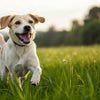What Can a Dog Eat to Gain Weight: A Comprehensive Guide for Pet Parents
- Houndsy
Table of Contents
- Introduction
- Understanding Your Dog's Weight
- What Can a Dog Eat to Gain Weight?
- Exercise and Weight Gain
- Monitoring Progress
- Conclusion
- FAQ
Introduction
Have you ever looked at your beloved pup and noticed their ribs protruding more than you’d like? You're not alone. Many pet parents find themselves concerned about their dogs being underweight, especially when they notice a sudden drop in weight or an inability to gain weight, even with regular feeding. According to recent veterinary studies, an alarming number of dogs are classified as underweight, which can lead to potential health issues.
Understanding what your dog can eat to gain weight is crucial for promoting their overall health and well-being. In this blog post, we will explore effective strategies to help your dog reach a healthy weight, including dietary changes and lifestyle adjustments. We’ll discuss the types of foods that are beneficial, the importance of portion control, and how to create a positive feeding environment. By the end, you’ll have actionable insights to enhance your dog's feeding routine and support their weight gain journey.
We invite you to reflect on your own pet feeding practices as we guide you through this essential topic. Let’s dive into the details of what can a dog eat to gain weight and how we can help our furry friends thrive.
Understanding Your Dog's Weight
The Importance of a Healthy Weight
Maintaining an ideal weight is essential for your dog's overall health. Dogs that are underweight may experience a range of problems, including weakened immune systems, reduced energy levels, and potential organ dysfunction. According to veterinary experts, dogs should have a Body Condition Score (BCS) between 4 and 5 on a scale of 1 to 9 for optimal health. A score lower than this typically indicates that your dog may be underweight.
Signs Your Dog is Underweight
How do you know if your dog is underweight? Here are some key indicators:
- Visible Ribs and Spine: If your dog’s ribs and spine are easily felt without a layer of fat, they may be underweight.
- Lack of Muscle Tone: A lack of muscle definition is another sign.
- Fatigue: If your dog seems lethargic or less energetic than usual, it may be time to assess their weight and diet.
- Unusual Eating Habits: If your dog is a picky eater or seems uninterested in their food, this could lead to weight loss.
If you suspect your dog is underweight, it’s important to consult with a veterinarian to rule out any potential health issues.
What Can a Dog Eat to Gain Weight?
Nutrient-Rich Foods
When it comes to helping your dog gain weight, the focus should be on nutrient-dense foods that are high in protein and fat. Here are some excellent options:
1. High-Quality Dog Food
Choosing a high-quality dog food formulated for weight gain is essential. Look for options that contain:
- High Protein: Protein sources like chicken, beef, or fish should be the first ingredient.
- Healthy Fats: Ingredients such as chicken fat, fish oil, or flaxseed oil provide necessary calories and fatty acids.
2. Human Foods to Boost Calories
Incorporating safe human foods can also help your dog gain weight. Some great options include:
- Peanut Butter: Dogs love peanut butter! It’s calorie-dense and packed with healthy fats. Just ensure it doesn’t contain xylitol.
- Cottage Cheese: This is a great source of protein and can be a tasty addition to their meals.
- Eggs: Scrambled or boiled, eggs are an excellent source of protein and healthy fats.
- Pumpkin and Sweet Potatoes: These are not only nutrient-dense but also help with digestion.
3. Fatty Treats
Treats can be a handy way to add extra calories. Look for those that are high in fat and protein:
- Raw Meats: Lean meats like chicken thighs or beef can be enticing and nutritious.
- Fish: Canned tuna or sardines (in water) can be a special treat that dogs love.
Adjusting Meal Frequency and Portion Size
Adjusting how often and how much you feed your dog can significantly impact their weight gain.
1. Smaller, More Frequent Meals
Feeding your dog smaller meals throughout the day can help their digestive system process food more effectively. This approach can prevent bloating and allows for better nutrient absorption.
2. Gradually Increase Portion Sizes
If you’re currently feeding your dog a standard portion, consider gradually increasing it by about 10-15%. Monitor their weight and adjust accordingly.
Enhancing the Feeding Environment
Creating a positive feeding environment can also encourage your dog to eat more. Here are a few tips:
- Reduce Stress: Ensure your dog feels safe and relaxed during meal times.
- Limit Distractions: Feed your dog in a quiet space away from other pets or loud noises.
- Routine Feeding Schedule: Establish a consistent feeding schedule. Dogs thrive on routine, and knowing when to expect meals can reduce anxiety.
Exercise and Weight Gain
While it may seem counterintuitive, regular exercise is crucial for weight gain. Exercise helps build muscle, which is denser than fat and contributes to overall weight. Here’s how to balance exercise with weight gain:
1. Moderate Activity
Engage your dog in moderate exercise, such as daily walks or gentle play sessions. This will stimulate their appetite and help build muscle.
2. Avoid Overexertion
Be mindful not to over-exercise your dog, especially if they are underweight. Gradually increase the intensity and duration of their activities.
Monitoring Progress
Tracking your dog's weight and body condition is essential to ensure they are on the right path to gaining a healthy weight.
1. Regular Weigh-Ins
Weigh your dog regularly, ideally once a week, to monitor their progress. Keeping a journal of their weight can help you identify trends and adjust their diet accordingly.
2. Consult Your Veterinarian
Regular check-ups with your veterinarian are crucial. They can provide guidance on diet adjustments and ensure that your dog is gaining weight healthily.
Conclusion
Helping your dog gain weight is a journey that requires patience, diligence, and a thoughtful approach to their diet and exercise. By incorporating high-quality, nutrient-rich foods, adjusting feeding habits, and creating a positive environment, we can support our furry friends in reaching a healthy weight.
At Houndsy, we understand the importance of making mealtime enjoyable and stress-free. Our flagship product, the Houndsy Kibble Dispenser, is designed to simplify the feeding process while enhancing your home’s decor. With our innovative design, you can ensure your dog gets the right portions every time, effortlessly.
If you’re looking to elevate your dog-feeding experience, we invite you to explore the Houndsy Kibble Dispenser today.
FAQ
What are the best foods for a dog to gain weight?
High-quality dog food that includes protein and fat, along with human foods like peanut butter, cottage cheese, and eggs, are excellent options.
How often should I feed my dog to help them gain weight?
Feeding smaller, more frequent meals is recommended. Aim for 3-4 meals per day if possible.
Can I mix human food with dog food for weight gain?
Yes, you can mix safe human foods with their dog food for added calories and nutrients. Always consult your vet for safe options.
How can I tell if my dog is gaining weight healthily?
Regular weigh-ins and monitoring your dog's body condition score will help you assess whether they are gaining weight appropriately.
Should I consult my vet if my dog is not gaining weight?
Yes, if your dog is not gaining weight despite dietary adjustments, consult your veterinarian to rule out any underlying health issues.












